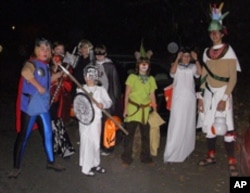Anecdotal evidence from many cities across the United States suggests that the time-honored Halloween tradition called trick or treating is in decline.
Halloween is an informal holiday on the last day of October that has its origins in medieval harvest rituals and pagan festivals of the dead. In modern times, mostly in English-speaking nations, children - and increasing numbers of party-going adults - dress in fanciful, sometimes scary Halloween costumes - as ghosts, werewolves, spiders and the like, all in the name of harmless good fun.
October 31 became an occasion for short family outings in which one or both parents accompanied their costumed children around the neighborhood. The kids would scramble up a neighbor's steps, ring the doorbell, and cry out trick or treat when the door opened. The neighbor, in turn, would exclaim over the creative costumes, then dispense candy, apples, or other goodies and wish the zombies and fairy princesses a Happy Halloween.
But the number of trick-or-treaters seems to be dwindling each year. Concerned about the safety of darkened streets and the treats handed out by strangers, many parents prefer to send their children to supervised gatherings at houses of worship, or to private costume parties thrown by neighbors.
Some religious families object to the holiday entirely, saying that it celebrates evil and the devil. Increasing numbers of porch lights are left off in some neighborhoods, too - signaling that the household will not welcome trick-or-treaters - because the residents are annoyed by gravelly voiced beggars in frightening costumes who continue to come knocking, well into their teens.
And in a tight economy, some residents no longer want to go to the time, trouble, and expense of buying candy and decorating their houses for Halloween.
The upshot is that come dusk this Sunday night across America, little ghouls and make-believe starlets will be about. Likely, though, not as many as last Halloween.








